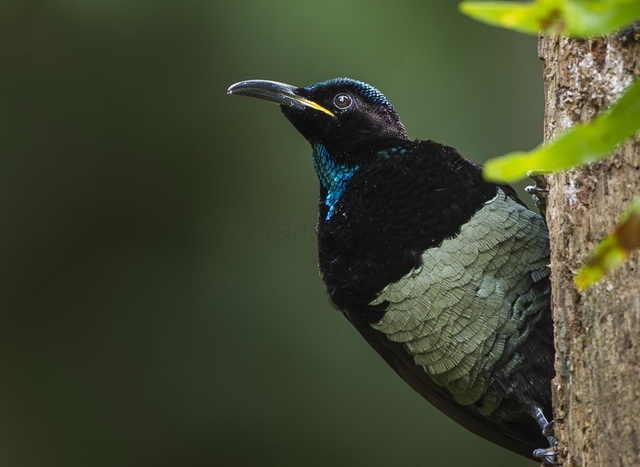Almost no light escapes from of bird of paradise feathers
Many birds of paradise have beautiful colours, the brightness of which partly is an illusion, created by dark feathers that surround coloured patches. These feathers are not normal black, but velvety super black, as Dakota McCoy and colleagues show.
Birds of paradise, which mainly occur in New Guinea, deserve their name. The bird family includes many species in which the males have brilliant colours, wear exuberant plumage ornaments and perform exciting dances. With their spectacular appearance, they try to seduce females.
Black feathers play an important role in their courtship, Dakota McCoy and colleagues write. The black feathers that these birds display are not normal black, but super black: they absorb almost all light – more than 99.5 percent – that falls on it. Against this velvety super black background, blue and yellow colours seem brighter than they really are; it looks as if the colours were luminescent. Such super black material is extremely rare in nature.
Ragged, curled edges
The researchers show that the deep black appearance is brought about by the special surface structure of the smallest components of the feathers. A feather consists of a shaft on which barbs are implanted, and the barbs are densely packed with barbules. Normally, these barbules are smooth and just bear hooks that interlock to make the feather stiff. The black feathers of crows and ravens have such normal barbules, as do the black feathers of birds of paradise that play no role in their show, such as back feathers.
But the barbules of super black feathers are highly modified. They have very ragged, curled edges with which deep, curved cavities in between, and this structure retains almost all light that falls on it. A normal black surface absorbs 95 to 97 percent of the incident light and reflects the remaining 3 to 5 percent. But in the micro jungle of spikes and cavities of super-black feathers, the light hits obstacles that scatter it again and again, and each time part of the light is transmitted into the material, where it is absorbed. Ultimately, less than half a percent of the incident light is reflected, so the feathers look super black for someone who faces the male – for instance a choosy female.
Photo: Victoria’s riflebid, Ptiloris victoriae, courting male. Francesco Veronesi (Wikimedia Commons, Creative Commons CC BY-SA 2.0)
Watch paradise birds in a video of BBC Earth, and another one of BBC Earth, and one of Cornell University featuring the magnificent riflebird.
Source:
McCoy, D.E., T. Feo, T.A. Harvey & R.O. Prum, 2018. Structural absorption by barbule microstructures of super black bird of paradise feathers. Nature Communications 9:1. Doi: 10.1038/s41467-017-02088-w
